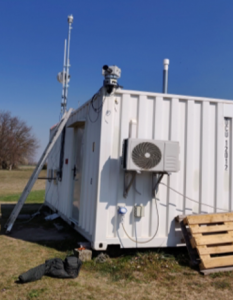SkySpec-2D
The SkySpec-2D instrument, developed by Airyx, is composed of three components:
- the telescope used to collect the light and located on the roof of the shelter (see figure),
- the spectrometer box located inside the shelter and linked to the telescope via optical fiber, and
- a laptop used to drive the automatic acquisition and to save the spectra.
The telescope is equipped with a mercury (Hg) lamp that allows to perform routinely spectral calibration measurements exploiting the well-known positions of the Hg emission peaks. In order to prevent condensation in the optical and electronic components, the telescope is internally heated, and silica gel is present inside both the telescope and spectrometer box.
The telescope has a Field Of View (FOV) of about 0.3° and is designed to collect light from every azimuth and zenith direction. For each measurement, two spectra with a spectral resolution of 0.6 nm, are simultaneously acquired: one in the VIS from 410 to 550 nm and the other in the UV from about 300 to 410 nm. The measurement integration time is automatically set by the acquisition software MS-DOAS to prevent the saturation of the Charge Coupled Device (CCD) sensor.
Currently, the SkySpec-2D is performing MAX-DOAS scans in three azimuth directions: 135° (SE), 250° (SW) and 315° (NW). For each direction, spectra are acquired at several elevation angles with respect to the horizon position (1°, 2°, 3°, 5°, 10°, 30°, 90°) to have information on different atmospheric layers. The acquisition of a spectrum requires about 20 seconds and the saved spectrum is the sum of several spectra (the number of co-added spectra is variable and depends on the integration time automatically set) with the purpose of increasing the Signal to Noise Ratio (SNR). Every night, SkySpec-2D performs calibration measurements that consist of Hg spectra for the spectral calibration and dark measurements to correct for the offset and dark current. The atmospheric acquisitions automatically start during the morning and stop during the evening. In particular, only zenith-sky spectra are acquired when the Solar Zenith Angle (SZA) with respect to the horizon is in the range between 4° below the horizon and 5° over the horizon. On the other hand, MAX-DOAS scans are acquired during the whole day, when the SZA is higher than 5° over the horizon.




